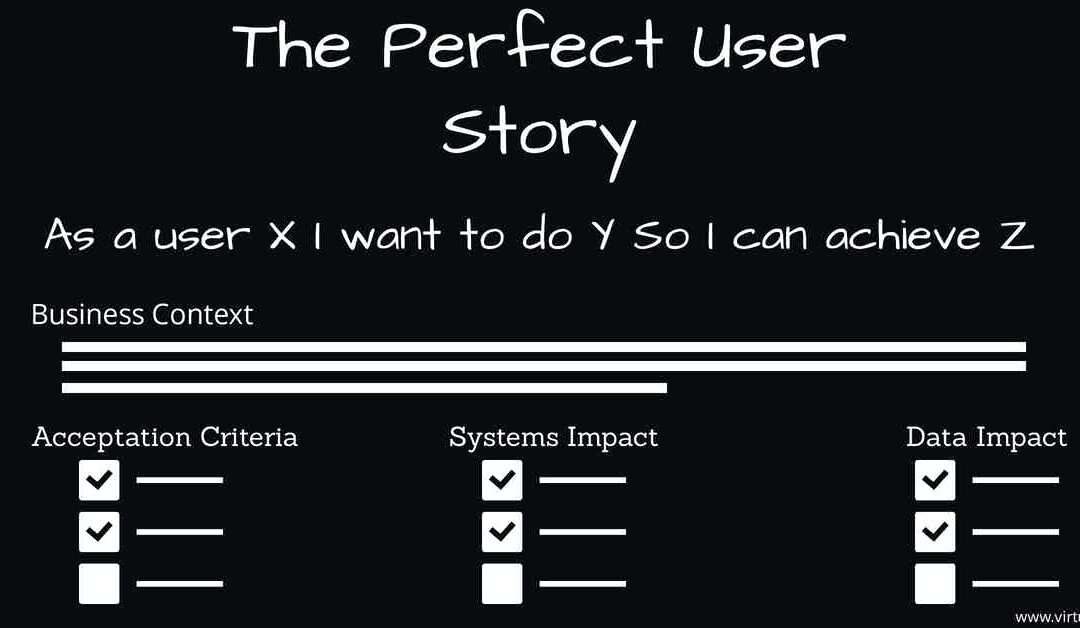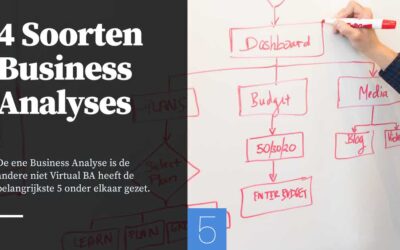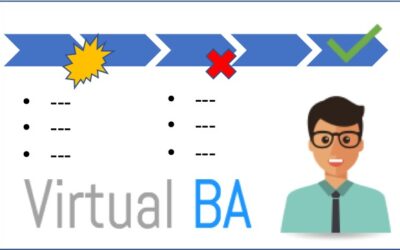Often it is believed that a perfect User Story is written like: “As a user X I want to do Y So I can achieve Z”. Some people also believe that this is all what needs to be written down for a development team to create the right results.
Therefore, it is not surprising that most development teams have a hard time estimating stories and that their velocity fluctuate.
Below some tips to improve your User Stories so you will get the functionality you want and your development team is able to create the right value:
1. Create a Short Name
Create a short name for each User Story, so you are able to recognise a story easily on the backlog and so you are able to have efficient communication about your story.
2. Use the User Story Syntax
Use the User Story Syntax “As a user X I want to do Y so I can achieve Z, as the introduction to the description of the desired functionality. The User Story Syntax ensures that the to be developed functionality will be used by somebody and that it wil generate some value for this person.
- Who your stakeholder will be : (user X)
- What kind of functionality he wants to have (Y)
- Why he wants to have it thus the added value (Z)
3. Add Additional context
Because the User Story Syntax just creates a high level understanding about the desired functionality it is a good practice to add additional context. For example some business context about the situation where the functionality is needed, or to create insight in the bigger picture. Really important to the business context is to write down who requested the functionality so you are able to contact this person again later on if needed.
4. Define Succes
Really important part of creating Perfect User Stories is to define the Success Factors. These Success Factors should be able to proof the implementation was a success and created the expected value. Examples of SuccessFactors for Perfect User Stories are:
- Indication of the amount of time which will be saved
- Increase in number of sales.

5. Add Acceptance Criteria
Add Acceptance criteria to the User Story. Acceptance Criteria will be the requirements which needs to be fulfilled in order to finish the release the functionality. The acceptance criteria can be used as input for creating test cases. And don’t forget the non functional acceptance criteria
6. Create Unique Identifiers
Create unique identifiers for your Acceptance criteria so you are able to reuse them if possible (for example for non functional acceptance criteria) this saves you a lot of work.
7. Identify data
Identify which data is necessary for execution of the functionality. This ensures that your developers will know what kind of integrations are necessary to complete the story. This will also make you aware of possible privacy risks in an early stage.
8. Determine Impact
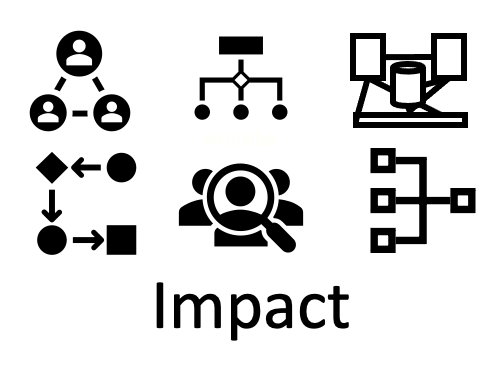
In a Perfect User Story is described which impact on other systems and business processes can be expected. For example which process needs to be changed, which systems needs to be changed or needs to be integrated.
9. Log decisions
Create an overview of architectural principles, design constraint and other decisions so you don’t have to redo all discussions over and over again.
10. Visualize
Create a visualisation about how the solution should work this will help in discussion and understanding. Examples of methods to be used for visualisation are:
- Use case diagrams –> perfect for visualising functionality with stakeholders and integrations
- Activity or BPMN diagrams –> perfect for visualising flow on a business level or within a system.
- Sequence diagrams, –>which are perfect for visualising integration between components.
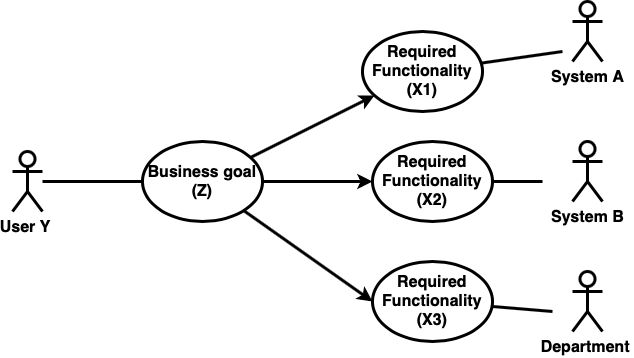
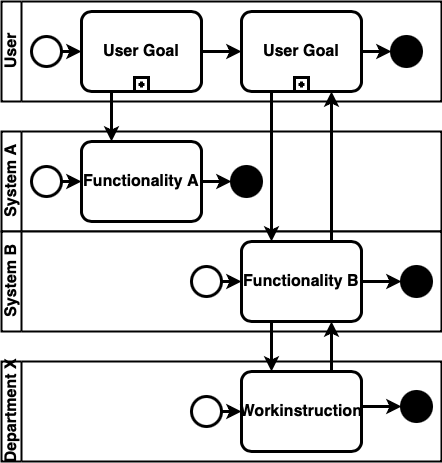
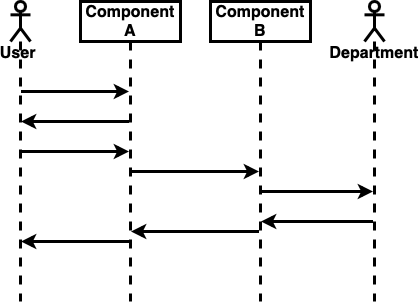
3 step approach for creating Perfect User Stories
Creating a perfect User Story at once is not Agile and can be even a waste of time. Therefore Virtual BA uses a 3 step method to create Perfect User Stories:
Step 1: Identify User Stories and place them on the backlog with a short name, User Story Syntax(As I user X etc), a little bit of business context, the original requestor or source
Step 2: Detail. Have a session with the original requestor and add details to the business context, create acceptance criteria and define the succesfactors
Step 3: Determine Impact. Identify the impact and dependencies of the user story in relation to systems, components etc.
Need Help?
Ask Virtual BA
More on Agile Business Analyses
How to use ChatGPT for Efficient Business Process Modeling: A Guide
In my previous post, I discussed the potential of generating diagrams with ChatGPT. Today, I'll dive deeper into how you can leverage ChatGPT for business process modeling effectively, ensuring you save time while maintaining accuracy in your diagrams. What you need...
Using ChatGPT for Process Modeling: Flowcharts, Sequence Diagrams, and More
In my last post, I shared how you can use ChatGPT to generate user stories. But did you know that ChatGPT is also highly effective for creating flowcharts, sequence diagrams, and other essential diagrams for Process Modeling? Creating diagrams is a core skill for...
Het schrijven van User Stories met ChatGPT
Sommige mensen denken dat het schrijven van user stories hetgeen is waar Business Analisten (BA's) het meest van genieten. Per slot van rekening bestaat een groot deel van het werk van BA’s uit user stories, epics (grote verhalen), of soms PowerPoint-presentaties, die...
Omgaan met Wettelijke Requirements
u
Hoe je je Epics Episch maakt
Een Epic is een user story die niet binnen één sprint te ontwikkelen is, is een vuistregel die veel projecten hanteren om Epics te identificeren. Als je het mij vraagt ben je dan eigenlijk net te laat en mis je heel veel aspecten van een Epic waarmee je effectief je...
Type Business Analyses
3 Situaties die baat hebben bij een Business Analyse In dit artikel leg ik uit in welke situaties een Business Analyse toegevoegde waarde biedt en waarom. Digitalisering van bedrijfsprocessen Integratie van verschillende systemen Introductie nieuw product of...
De 5 soorten analisten in het Digitale/IT domein
Een ruit is een vlieger maar een vlieger is geen ruit, dit zei mijn wiskunde leraar vroeger altijd. Waarmee hij bedoelde dat vormen op elkaar kunnen lijken maar dat de eigenschappen verschillend zijn. Deze filosofie is ook van toepassing op een Business Analist,...
5 Tips voor het effectief optimaliseren van bedrijfsprocessen
Klinkt natuurlijk wel lekker dat optimaliseren van bedrijfsprocessen. Maar hoe weet je nu eigenlijk dat je bedrijfsproces is geoptimaliseerd en wat is een bedrijfsproces eigenlijk. In dit artikel leg ik uit wat een bedrijfsproces is, hoe je weet dat het...
7 Fouten die veel Digitale en IT projecten maken.
Alle nieuwe ontwikkelingen en methodieken ten spijt. Digitale en IT projecten blijven keer op keer dezelfde fouten maken. Hieronder de belangrijkste 7 denkfouten: Requirement overslaan want dat is waterval Opstellen van oplossingsgerichte requirements Oplossing...
